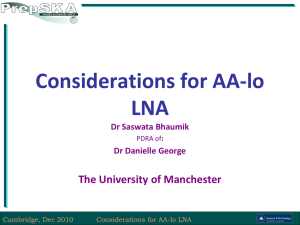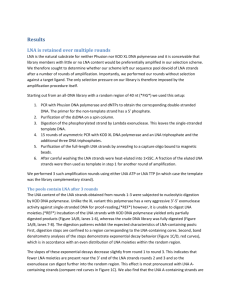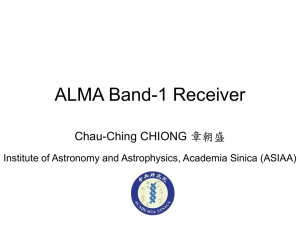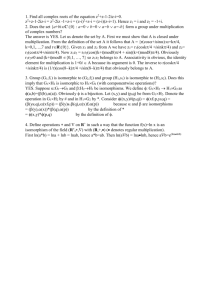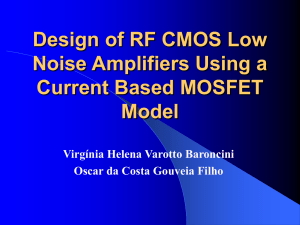LNA is retained over multiple rounds
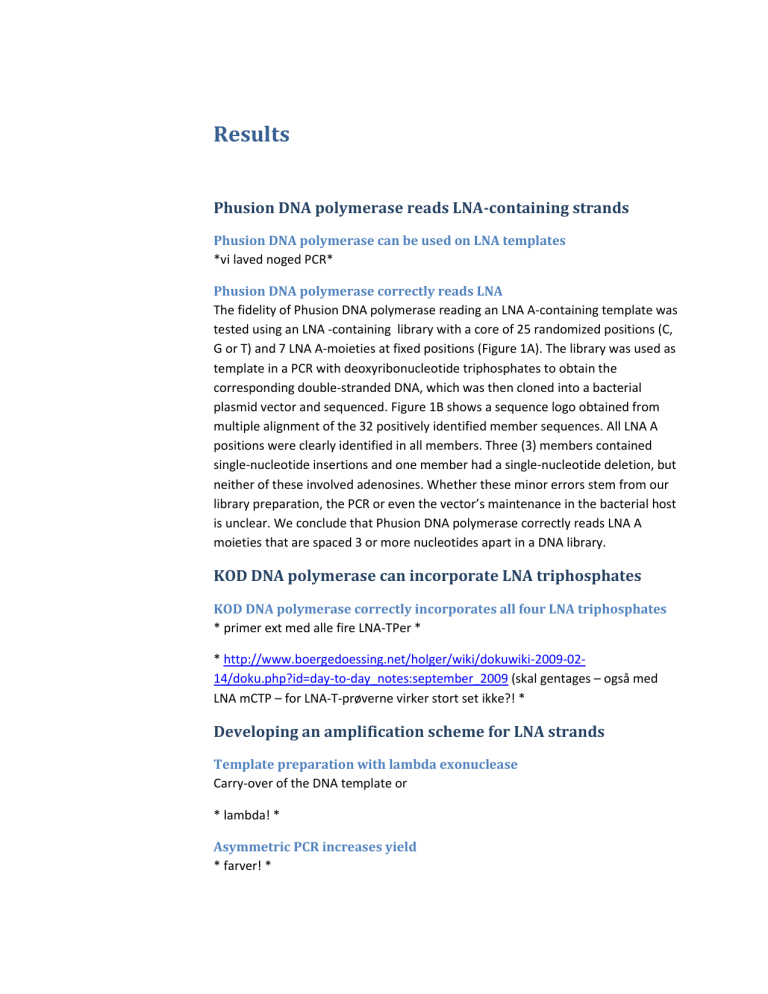
Results
Phusion DNA polymerase reads LNA-containing strands
Phusion DNA polymerase can be used on LNA templates
*vi laved noged PCR*
Phusion DNA polymerase correctly reads LNA
The fidelity of Phusion DNA polymerase reading an LNA A-containing template was tested using an LNA -containing library with a core of 25 randomized positions (C,
G or T) and 7 LNA A-moieties at fixed positions (Figure 1A). The library was used as
template in a PCR with deoxyribonucleotide triphosphates to obtain the corresponding double-stranded DNA, which was then cloned into a bacterial
plasmid vector and sequenced. Figure 1B shows a sequence logo obtained from
multiple alignment of the 32 positively identified member sequences. All LNA A positions were clearly identified in all members. Three (3) members contained single-nucleotide insertions and one member had a single-nucleotide deletion, but neither of these involved adenosines. Whether these minor errors stem from our library preparation, the PCR or even the vector’s maintenance in the bacterial host is unclear. We conclude that Phusion DNA polymerase correctly reads LNA A moieties that are spaced 3 or more nucleotides apart in a DNA library.
KOD DNA polymerase can incorporate LNA triphosphates
KOD DNA polymerase correctly incorporates all four LNA triphosphates
* primer ext med alle fire LNA-TPer *
* http://www.boergedoessing.net/holger/wiki/dokuwiki-2009-02-
14/doku.php?id=day-to-day_notes:september_2009 (skal gentages – også med
LNA mCTP – for LNA-T-prøverne virker stort set ikke?! *
Developing an amplification scheme for LNA strands
Template preparation with lambda exonuclease
Carry-over of the DNA template or
* lambda! *
Asymmetric PCR increases yield
* farver! *
* skal nok gentages med: 1) nyere protokol, 2) både 2080 og 2080-T. Bemærk!
Her bruges regulær KOD DNApol.!! *
*NB! Denne figur mangler gel for dATP-reaktionen! Kan vi undvære den? Det skal formodentlig gentages! *
* Desuden er dette lavet med regulær KOD DNApol., ikke XL! *
*VI SKIFTEDE TIL KOD XL – HVORFOR?*
Purification of full-length LNA strands
* dynabeads *
LNA strands are specifically amplified
* pcr qc *
LNA is retained over multiple rounds
LNA is the natural substrate for neither Phusion nor KOD XL DNA polymerase and it is conceivable that library members with little or no LNA content would be preferentially amplified in our selection scheme. We therefore sought to determine whether our scheme left our sequence pool devoid of LNA strands after a number of rounds of amplification. Importantly, we performed our rounds without selection against a target ligand. The only selection pressure on our library was therefore imposed by the amplification procedure itself.
Starting out from an all-DNA library with a random region of 40 nt (*FIG*) we used this setup:
1.
PCR with Phusion DNA polymerase and DNA triphosphates to obtain the corresponding double-stranded DNA. The primer for the non-template strand carried a 5 ′ phosphate.
2.
Purification of the dsDNA on a spin column.
3.
Digestion of the phosphorylated strand by Lambda exonuclease. This left the single-stranded template DNA.
4.
15 rounds of asymmetric PCR with KOD XL DNA polymerase and an LNA triphosphate and the additional three DNA triphosphates.
5.
Purification of the full-length LNA strands by annealing to a capture oligo bound to magnetic beads.
6.
After careful washing the LNA strands were heat-eluted into 1×SSC. A fraction of the eluted LNA strands were then used as template in step 1 for another round of amplification.
We performed 3 such amplification rounds using either LNA ATP or LNA TTP (in which case the template was the library complementary strand).
The pools contain LNA after 3 rounds
The LNA content of the LNA strands obtained from rounds 1-3 were subjected to nucleolytic digestion by KOD DNA polymerase. Unlike the KOD XL variant this polymerase has a very aggressive 3-5 ′ exonuclease activity against single-stranded
DNA (*REF*), however, it is unable to digest LNA moieties (*REF*). Incubation of the LNA strands with KOD DNA polymerase yielded only partially digested
characteristics of LNA-containing pools: First, digestion stops – visible as a smear – are confined to a region corresponding to the LNA-encoding cores. Second, line
densitometry curves (Figure 2C/D, red curves) of these regions appear to have set
decay rates. This is in accordance with a uniform distribution of LNA moieties within the randomized cores.
The exponential decay rates (slope) decrease slightly from round 1 to round 3.
This indicates that fewer LNA moieties are present near the 3 ′ end of the LNA strands rounds 2 and 3 and so the exonuclease can digest further into the random region. This effect is most pronounced with LNA A-containing strands (compare
red curves in Figure 2C). We also find that the LNA A-containing strands are less
stable against nucleolytic attack than LNA T-containing strands, as reflected in the lower decay constants; this could be due to a higher LNA content and/or higher
nuclease stability of the LNA T-containing strands (compare red curves in Figure 2C and Figure 2D).
Nucleotide compositions are skewed towards ***
Next, we wanted a quantitative measure of the LNA content in our pool. We approached this by analyzing the nucleoside composition of our LNA strand pools.
This can be done by digesting the DNA of interest with nuclease P1, phosphodiesterase I, and alkaline phosphatase (*REF*) and subjecting the resulting nucleoside mix to LC-MS. However, due to the nuclease resistance of
(successive) LNA moieties we opted to use Phusion DNA polymerase on our LNA strands to obtain the corresponding double-stranded DNAs. By using a doublybiotinylated primer for the template-encoding strand we were able to immobilize the DNA on streptavidin-coated magnetic beads and subsequently heat-elute the complementary strand (*FIG*). The eluted single-stranded DNA oligomers were therefore iso-sequential to the original LNA strands and could easily be digested and analyzed by LC-MS.
******
** NOGET OM AT LNA-INDHOLDET STABILISERES HEREFTER ***
Sequence analysis indicates fewer ‘LNA islands’
Finally, we looked at the sequence composition at the basal level by sequencing.
Clones were obtained by amplifying either the crude DNA library or LNA A- or LNA
T-containing strands from round 3 with Phusion DNA polymerase and cloning the resulting DNA into a plasmid vector. Sequencing yielded between *XXX-XXX* clones. While the crude library encodes many adenosine or thymidine duplets and triplets (*FIG*) these were remarkably absent from the LNA-containing pools obtained after 3 rounds of our selection scheme (*FIG*). The average distance between LNA moieties within the random region was *XXX.X* nt for the LNA Acontaining pool and *XXX.X* nt for the LNA T-containing pool (*FIG: søjlediagram over afstande mellem Aer eller Ter i de forskellige pools. Husk at angive n [antal kloner] og gennemsnitsværdi.*).
Materials & Methods
Oligonucleotides
*NAC2080, F2080, R2080 m/u modifikationer, 2080-T, 2080-G, 2080-C og tilhørende primere m/u modifikationer, capture oligo(er), NAC2919 A70, AT50,
AT50’ primere m/u modifikationer.*
Polymerase chain reaction (PCR)
0.5 nM template (all-DNA or LNA-containing single-stranded DNA) and 0.5 µM of each primer were combined in 1× Phusion HF buffer with 200 µM of each deoxyribonucleotide triphosphate and 0.04 units/µl Phusion DNA polymerase. PCR conditions were typically: 98 °C/5 min., 20 cycles (98 °C/5 s, 53 °C/10 s, 72 °C/5 min.), 4 °C/hold.
Lambda exonuclease digestion
Primer extension
Oligo capture on magnetic beads
Digestion assay
Ca. 1.5 pmol of LNA-containing strands isolated after 1, 2 or 3 rounds of amplification and regeneration of library AT50 (*TABEL?*) were 5 ′ -radiolabelled.
Full-length oligomers were isolated on a 6% denaturing polyacrylamide gel and eluted into 100 µl water each. Sample volumes were then adjusted to achieve equivalent specific activity. Similarly, the crude DNA library and an LNA A oligomer
(5 ′ -GGTCTGGTCCACACCCAGCCGCCaCCCaGGGaCGCaGCCaGGCaCGGCGGGCCTA-
TAGTGAGTCGTATTA; lower case is LNA A) were 5 ′ -radiolabelled to 7.5 nM. 5 µl of each oligomer was then incubated at 72 °C in digestion buffer (1× KOD buffer #2, 3 mM MgSO
4
, 0.2 mg/ml BSA) with or without 0.2 units KOD DNA polymerase
(Novagen) (10 µl final volume). 1.5 µl samples were drawn at intervals, quenched in 1 vol. ice-cold 95% formamide/50 mM EDTA and resolved on 13% denaturing polyacrylamide gels. Autoradiography was with the PhosphoImager system
(*MANUF*), and line densitometry was with spline curves (width: 30) in ImageJ
1.44j (NIH). Data pairs (i.e. with/without polymerase) were matched to achieve identical overall intensity and then normalized (Excel 2010, Microsoft).
LC-MS analysis
Sequencing
Phusion DNA polymerase was used to generate double-stranded DNA from LNAcontaining templates. The DNA was then 5 ′ -phosphorylated and blunt-end cloned into SmaI-digested pUC19 ; this offers multiple inserts per plasmid. The plasmids were transformed into E. coli TOP10. 22 re-streaked colonies were chosen for plasmid purification (Miniprep, Qiagen). Cycle sequencing at Eurofins MWG
Operon (D) was with the ‘M13 rev (−49)’ primer and yielded 32 library member sequences. Multiple sequence alignment was with ClustalW 1.83 (*REF*) and
JalviewLite 2.6.1 (*REF*), and sequence logos were created with WebLogo 2.8.2
(http://weblogo.berkeley.edu/; *REF*).
Figures
A
5 ′ -GGACAGGACCACACCCAG-aBBBBaBBBaBBBaBBBaBBBaBBBaBBBB-GGCCTTTTGTGTGTCGTTT-3 ′
B
Figure 1: Phusion DNA polymerase correctly reads an LNA A-containing DNA template.
(A) Sequence of the DNA library used. Lowercase ‘a’ denotes LNA A moieties; ‘B’ denotes C, G or T. (B) Sequence logo of the randomized core of the sequenced library members. All LNA A-positions were clearly identifiable in all 32 members.
Positions 1, 20 and 30 are alignment artifacts caused by single-nucleotide insertions in three members. Another member had a single-nucleotide deletion
(aligned to pos. 25).
*Første del af figuren burde måske være noget med at vise amplifikationssetuppet.*
*Anden del af figuren kunne så være en illustration af den måde biblioteket aflæses den ene hhv. den anden vej.*
A B
C D
Figure 2: Both LNA A and LNA T are retained in libraries over 3 rounds of amplification, but LNA T offers superior incorporation and/or stability.
A library (40 nt fully randomized) was used as template for making LNA-containing strands, which were used in subsequent rounds of amplification in order to test whether our amplification scheme entails intrinsic selection pressure against LNAcontaining pool members. LNA content of strands from round 1-3 was assayed by digesting with a 3 ′ -5 ′ deoxyribonuclease (KOD DNA polymerase) that cannot digest past LNA moieties. (A, B) Digestion analysis of strands amplified using LNA ATP (A) or LNA TTP (B). Lanes 1-6 show 5 ′ -radiolabeled LNA strands incubated at 37 °C/20 min. without or with nuclease. The position of the LNA-induced digestion stops is consistent with the expected position of the LNA moieties in the oligomer pools.
Lanes 7, 8: The all-DNA crude library is fully degraded. Lanes 9, 10: Digestion of an
LNA A-containing oligomer yields stops at the expected intervals. All the digestive patterns shown here remained virtually identical after 80 min. (not shown). (C, D)
Densitometry scans of lanes 1-6 in A and B. Total pixel intensities of lane pairs (i.e.
with and without nuclease) were matched, and all pairs were then normalized for direct comparison. Blue curves indicate ‘without nuclease’, red curves indicate
‘with nuclease’. Curve brightness reflects round number. (C) As expected for a fully randomized library the intensity of the nuclease stops fits an exponential decay function. The decay slope decreases from round 1 to round 3, indicating that the LNA A content in the pool decreases. (D) Similarly, the LNA content also decreases in a pool propagated with LNA TTP. However, the densitometry curves are higher and steeper than for the LNA ATP-propagated pool, suggesting that LNA
TTP offers better incorporation and/or higher stability.
